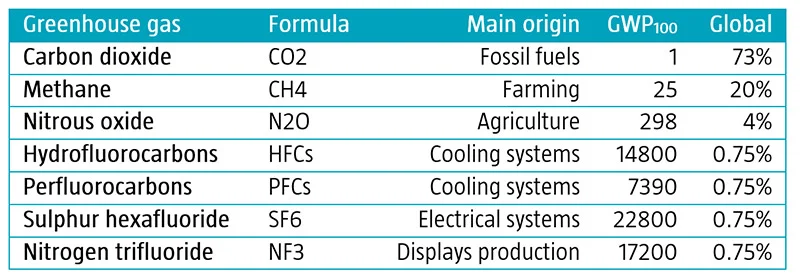When speaking about carbon emissions we often mean carbon dioxide equivalents instead of just carbon dioxide. But what does this ‘equivalent’ exactly mean? Well, carbon dioxide is not the only molecule contributing to global warming – there are many different molecules that possess greenhouse gas effects. This memo explains how this ‘equivalent’ is used to measure the effects of many different greenhouse gases together.
In the Kyoto protocol (1997), initially six different greenhouse gases were considered. These are shown as the first six gases in the table below. In 2013, nitrogen trifluoride was added as the seventh official greenhouse gas. Besides the gases in the table, ozone and water vapor are also important greenhouse gases. However, these are not included in the greenhouse gas protocol as their presence in the atmosphere is only limitedly influenced by mankind.

The different greenhouse gases in the table all have the ability to increase the temperature of the planet, though their impact substantially differs. To make the impact of the different greenhouse gases on the temperature comparable, the global warming potential (GWP) score was introduced.1 The GWP of a gas depends on how much heat the gas is able to absorb, and how the gas’s concentration decays over time.
I follow the market standard and look at warming potentials over a 100-year period. This is usually denoted as GWP100 and reported in the table for the seven Kyoto gases. The GWP is always expressed relative to carbon dioxide, of which the GWP is normalized to 1. For instance, methane has as GWP100 of 25, which implies that a ton of methane has 25 times higher effect on global warming than a ton of carbon dioxide over a 100-year period. When emitted, methane is actually much more than 25 times more potent than CO2, but it’s prevalence in the atmosphere decays much faster than CO2, which can remain in the atmosphere for thousands of years.
Please note the four very potent gases in the table, with SF6 topping the list, being 22,800 times more potent that CO2. These so-called fluorinated gases are thus extremely potent, and their increasing use is considered a rather large risk for future global warming. Much research on alternatives for the use of these gasses is currently being conducted to limit the future use of these gases.
The column ‘Global’ shows how much the seven Kyoto gases contribute to global warming. Carbon dioxide emissions are responsible for 73% of all global warming caused by mankind. Methane and nitrous oxide together account for 24% of global warming. The remaining 3% is caused by the four fluorinated gases.
In its annual survey, the CDP asks companies to break down the total reported scope 1 emissions (in tons of CO2e) into the seven Kyoto gases.2 Companies generally differ quite a lot in the gases they report CO2e figures for. Some companies only report emissions from CO2, while others also include emissions from other gasses, which can make comparisons difficult. For instance, does a lower total CO2e figure imply a cleaner company or is that company just not reporting on all Kyoto gases?
時刻把握我們最新市場觀點及電子報
接收荷寶電子報,率先閱讀最新洞察分析,並構建最綠色的投資組合。
免責聲明
本文由荷宝海外投资基金管理(上海)有限公司(“荷宝上海”)编制, 本文内容仅供参考, 并不构成荷宝上海对任何人的购买或出售任何产品的建议、专业意见、要约、招揽或邀请。本文不应被视为对购买或出售任何投资产品的推荐或采用任何投资策略的建议。本文中的任何内容不得被视为有关法律、税务或投资方面的咨询, 也不表示任何投资或策略适合您的个人情况, 或以其他方式构成对您个人的推荐。 本文中所包含的信息和/或分析系根据荷宝上海所认为的可信渠道而获得的信息准备而成。荷宝上海不就其准确性、正确性、实用性或完整性作出任何陈述, 也不对因使用本文中的信息和/或分析而造成的损失承担任何责任。荷宝上海或其他任何关联机构及其董事、高级管理人员、员工均不对任何人因其依据本文所含信息而造成的任何直接或间接的损失或损害或任何其他后果承担责任或义务。 本文包含一些有关于未来业务、目标、管理纪律或其他方面的前瞻性陈述与预测, 这些陈述含有假设、风险和不确定性, 且是建立在截止到本文编写之日已有的信息之上。基于此, 我们不能保证这些前瞻性情况都会发生, 实际情况可能会与本文中的陈述具有一定的差别。我们不能保证本文中的统计信息在任何特定条件下都是准确、适当和完整的, 亦不能保证这些统计信息以及据以得出这些信息的假设能够反映荷宝上海可能遇到的市场条件或未来表现。本文中的信息是基于当前的市场情况, 这很有可能因随后的市场事件或其他原因而发生变化, 本文内容可能因此未反映最新情况,荷宝上海不负责更新本文, 或对本文中不准确或遗漏之信息进行纠正。
